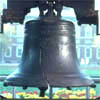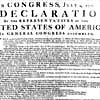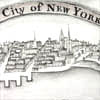 Text search Text search
 Related images Related images
 HistoryWorld HistoryWorld
 Link Link
 Map Map
Click the icons to visit linked content. Hover to see the search terms. |
|  |
| | | | | | | |
|
| 1776 |
| | | George Washington drives the British garrison from Boston, and moves south to protect New York | |  
| |
|
| 1776 |
| | | The revolutionary convention of Virginia votes for independence from Britain, and instructs its delegates in Philadelphia to propose this motion | | 
| |
|
| 1776 |
| | | Virginia's motion for independence from Britain is passed at the Continental Congress of the colonies with no opposing vote | |  
|  | Liberty Bell, Philadelphia
Fotofile CG
|
|
|
| 1776 |
| | | Thomas Jefferson's text for the Declaration of Independence is accepted by the Congress in Philadelphia | |   
| |
|
| 1776 |
| | | English historian Edward Gibbon publishes the first volume of The Decline and Fall of the Roman Empire | |   
| |
|
| 1776 |
| | | John Hancock is the first delegate to sign the Declaration of Independence, formally written out on a large sheet of parchment | |   
|  | The American Declaration of Independence in 1776
National Archives, Kew
|
|
|
| 1776 |
| | | George Washington, driven from New York by the British, retreats towards Philadelphia | |  
|  | Map of New York in 1765
National Archives, Kew
|
|
|
| 1776 |
| | | Spanish America is now administered as four viceroyalties - New Spain, New Granada, New Peru and La Plata | | 
| |
|
| 1776 |
| | | Buenos Aires rather than Asunción is chosen to be capital of the new Spanish viceroyalty of La Plata | | 
| |
|
| 1776 |
| | | Scottish economist Adam Smith analyzes the nature and causes of the Wealth of Nations | |   
| |
|
| | | | | |
| |